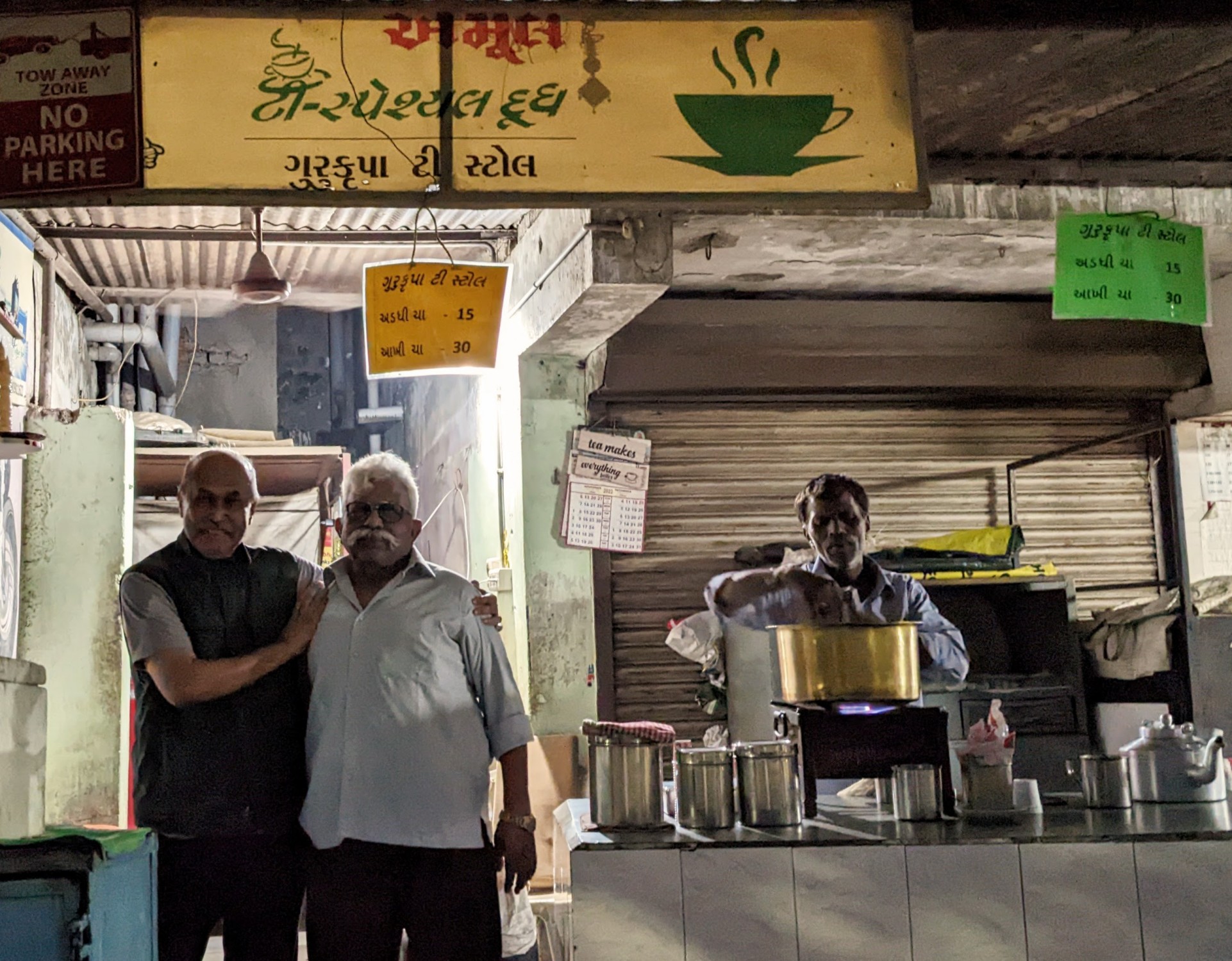On the outside, there is nothing remarkable about Gurukrupa Tea Stall. Located near the end of the arterial road of Azad Society, a sprawling human settlement in Ahmedabad, the stall is no different from the scores of small tea stalls all over the city. What had caught my attention however was that there was always a motley crowd of people and vehicles, including fancy cars, around the stall. At any time of the day, the traffic approaching the stall had to slow down as the leftmost lane of the road was invariably blocked by parked vehicles. About three weeks ago, as I drove the SUV towards the stall a little after 6 in the morning, I could see a couple of cars and several two-wheelers parked on the road near the stall. It was my first day of SUV driving lessons to fine-tune my judgment about the size and the power of an SUV. There was a nip in the cool morning air. On an impulse, turning to Prabhu who was seated next to me, I suggested, “Shall we stop for a cup of tea?” Prabhu said, “The tea served is excellent. People come to this stall from all over the city and even from outside Ahmedabad.” I looked at Prabhu with disbelief, and asked, “Is the tea really that good?”

The cluster of people was the first set of customers who had reached the stall even before it had opened properly. Water was boiling in a large brass pot kept over a roaring flame of a single gas burner that was kept on a stone platform. Fascinated, I watched the first batch of tea for the day being prepared by a stocky old man, presumably the tea stall owner. He added a couple of mugs of sugar, followed immediately by a mug of tea leaves to the boiling water. After half a minute, he added a smaller mug of some concoction which I later learned to be a mixture of cut spearmint (pudina) and ginger (adrak). A couple of minutes later, he added two mugs of milk, while continuously stirring the contents of the pot with a ladle to prevent the liquid from boiling over. He checked for consistency and aroma as he scooped up ladle-full of the concoction every now and then and airdropped the scooped concoction back into the pot. The aroma of the tea being prepared wafted through the air to the gathered customers.
The five minutes of stirring and scooping appeared an eternity to the eagerly waiting customers. The old man lowered the flame and lifted the pot from the burner using a thin cloth towel (gamchha) to grip with both hands the flattened protruding edge of the pot. The old man’s assistant in the meantime had readied a huge aluminum kettle to receive the contents of the pot. A thicker cloth towel acted as a sieve through which the contents of the vessel were poured into the kettle. We could see the thick brown liquid cascading from the pot into the kettle. The steam and the aroma tickled our nostrils and added to our impatience. The pot was then kept aside, and the cloth on the kettle was squeezed with flat-armed tongs to extract the last drops of liquid and then kept aside. Holding the kettle in his right hand by the handle across the round opening on top of the kettle, the assistant used his left hand, cushioned by a piece of cloth, to repeatedly tilt the base of the kettle to pour out the exact amount of tea to fill to the brim the neatly lined up paper cups on the platform. One by one those gathered approached the platform to pick a cup each.
I held the rim of the cup with the index finger and the thumb of my right-hand avoiding contact with the hot walls of the cup. Not used to drinking piping hot tea, I tentatively lifted the cup to my lips and took the first slurping sip. The tongue was singed not just by the heat but also by the pungency of the pudina and the adrak in the tea. As the liquid went down my gullet, I could sense the passage getting cleaned up and widened. The upper palate was filled with the flavor of the concoction as the vapors from the fluid filled the passage between the throat and the nasal cavity. I was awakened with a jolt. The lethargy of my senses vanished with the first sip. The subsequent sips produced the same sensation, albeit of lower intensity. By the time I finished drinking my cup of tea, I felt energetic, light-headed, and twinkle-toed.
The next day I revisited the tea stall before embarking on my driving lesson on the highway. The sensual experience of drinking the cup of tea was the same as on the first day. I asked the old man his name, “आपका नाम क्या है?”. “Keshubhai,” he said. I told him, “आपकी चाय बहुत अच्छी है।”. Then I asked him, “केशुभाई, आपने चाय की दुकान कब लगाई?” [“When did you set up the tea stall, Keshubhai?”]. Keshubhai replied, “मैं 1968 में मेहसाणा से अहमदाबाद आया था। मैं 14 साल का था। मेरे पिता की एक फार्मा कंपनी में नौकरी लग गई थी। मैंने 1978 में स्टॉल लगाया।” [“I came to Ahmedabad in 1968 from Mehsana. I was 14. My father got a job in a pharma company. I set up the stall in 1978.”]. He asked, “आप कहां के रहने वाले हैं?” [“Where are you from?”]. I told him that I resided in Azad Society and that I had retired after serving with IIMA for over three-and-a-half decades.
His eyes lit up when he heard about my long association with IIMA. He said that he had known many from the Institute who had been regular visitors to his tea stall in the early days. There was no fence between the Institute campus and the Azad Society which had very few houses at that time. He recalled that the Institute had even rented a few houses in Azad Society. Keshubhai recollected that first, a wire fence had come up in the eighties which was later replaced by a brick wall to separate the campus from Azad Society. I sensed his nostalgia when he told me that the clientele from the Institute that helped him establish the stall in the early days, had dwindled to near zero now.
I asked, “केशुभाई, मैं आप पर एक कहानी लिखना चाहता हूँ। क्या आपको वह ठीक लगता है?” [“Keshubhai, I want to write a story about you. Is that okay with you?”]. An amused Keshubhai said, “ठीक है।” [“It is okay with me.”]. I told him that I will publish the story and circulate the story among friends. I clicked a picture of Keshubhai and the stall and asked Prabhu to click me with Keshubhai and the stall. Prabhu later informed me that he had gathered from the customers that Keshubhai had discretely inquired and confirmed from them that I was indeed from IIMA.
My driving lessons continued for almost a week. Every day we would stop by Gurukrupa Tea Stall for our cup of steaming hot tea in the morning. I noted the consistency of the quality and the flavor of the tea served from one day to another. Also, the tea never failed to produce the awakening of my senses I had experienced on the first day. I reckoned that in the 44 years since setting up the stall, Keshubhai would have prepared over 5 million cups of tea. No wonder he had achieved perfection in making the tea he served to his satisfied and repeat clients. Over the course of the week, I discovered that it was indeed true that people from other cities, passing through Ahmedabad, stopped at Keshubhai’s tea stall for a piping hot cup of tea.
As per the Michelin Guide, one star is awarded to ‘high-quality cooking, worth a stop’; two stars are awarded to ‘high-quality cooking, worth a detour’; and three stars are awarded to ‘exceptional cuisine, worth a special journey’. Gurukrupa Tea Stall had customers in all three categories who would therefore give the tea stall a rating of one, two, and three Michelin stars. The last category of customers is those who specially made a trip to have their tea at the stall occasionally.
Every city has such stalls and eateries, that often serve a single or a few items with consistent quality as regards taste, flavor, and texture that is enjoyed by their faithful customers. These little-publicized places do not find a mention in the glitzy food and beverages magazines but deserve to be recognized for the service they provide at a low price to millions.
